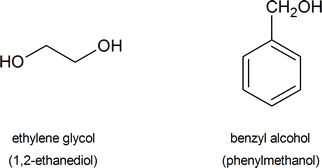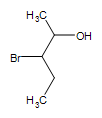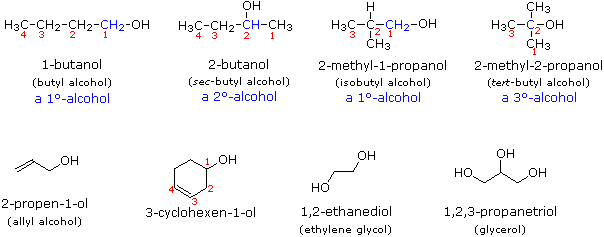17.1 Naming Alcohols and Phenols
- Page ID
- 90938
Objectives
After completing this section, you should be able to
- identify an alcohol as being primary, secondary or tertiary, given its structure, its IUPAC name or its trivial name.
- write the IUPAC name of an alcohol or phenol given its Kekulé, condensed or shorthand structure.
- draw the structure of an alcohol or phenol given its IUPAC name.
- identify a number of commonly occurring alcohols (e.g., benzyl alcohol, tert‑butyl alcohol) by their trivial names.
The following are common names of some alcohols (with IUPAC name).


Primary alcohols
In a primary (1°) alcohol, the carbon which carries the -OH group is only attached to one alkyl group. Some examples of primary alcohols include:
![Ethanol (CH3-CH2-OH), propan-1-ol (CH3-CH2-CH2-OH), and 2-methylpropan-1-ol (CH3-CH[CH3]-CH2-OH)](https://chem.libretexts.org/@api/deki/files/15557/primary.gif?revision=1&size=bestfit&width=398&height=61)
Notice that it doesn't matter how complicated the attached alkyl group is. In each case there is only one linkage to an alkyl group from the CH2 group holding the -OH group. There is an exception to this. Methanol, CH3OH, is counted as a primary alcohol even though there are no alkyl groups attached to the carbon with the -OH group on it.
Secondary alcohols
In a secondary (2°) alcohol, the carbon with the -OH group attached is joined directly to two alkyl groups, which may be the same or different. Examples:
![Structures of propan-2-ol (CH3CH[OH]CH3), butan-2-ol (CH3CH[OH]CH2CH3), and pentan-3-ol (CH3CH2CH[OH]CH2CH3)](https://chem.libretexts.org/@api/deki/files/15558/secondary.gif?revision=1&size=bestfit&width=389&height=80)
Tertiary alcohols
In a tertiary (3°) alcohol, the carbon atom holding the -OH group is attached directly to three alkyl groups, which may be any combination of same or different. Examples:

Naming Alcohols
- Find the longest chain containing the hydroxy group (OH). If there is a chain with more carbons than the one containing the OH group it will be named as a subsitutent.
- Place the OH on the lowest possible number for the chain. With the exception of carbonyl groups such as ketones and aldehydes, the alcohol or hydroxy groups have first priority for naming.
- When naming a cyclic structure, the -OH is assumed to be on the first carbon unless the carbonyl group is present, in which case the later will get priority at the first carbon.
- When multiple -OH groups are on the cyclic structure, number the carbons on which the -OH groups reside.
- Remove the final e from the parent alkane chain and add -ol. When multiple alcohols are present use di, tri, et.c before the ol, after the parent name. ex. 2,3-hexandiol. If a carbonyl group is present, the -OH group is named with the prefix "hydroxy," with the carbonyl group attached to the parent chain name so that it ends with -al or -one.
Examples
Ethane: CH3CH3 ----->Ethanol:  (the alcohol found in beer, wine and other consumed sprits)
(the alcohol found in beer, wine and other consumed sprits)
Secondary alcohol:  2-propanol
2-propanol
Other functional groups on an alcohol:  3-bromo-2-pentanol
3-bromo-2-pentanol
Cyclic alcohol (two -OH groups):  cyclohexan-1,4-diol
cyclohexan-1,4-diol
Other functional group on the cyclic structure:  3-hexeneol (the alkene is in bold and indicated by numbering the carbon closest to the alcohol)
3-hexeneol (the alkene is in bold and indicated by numbering the carbon closest to the alcohol)
A complex alcohol: 4-ethyl-3hexanol (the parent chain is in red and the substituent is in blue)
4-ethyl-3hexanol (the parent chain is in red and the substituent is in blue)
In the IUPAC system of nomenclature, functional groups are normally designated in one of two ways. The presence of the function may be indicated by a characteristic suffix and a location number. This is common for the carbon-carbon double and triple bonds which have the respective suffixes -ene and -yne. Halogens, on the other hand, do not have a suffix and are named as substituents, for example: (CH3)2C=CHCHClCH3 is 4-chloro-2-methyl-2-pentene.
Alcohols are usually named by the first procedure and are designated by an -ol suffix, as in ethanol, CH3CH2OH (note that a locator number is unnecessary on a two-carbon chain). On longer chains the location of the hydroxyl group determines chain numbering. For example: (CH3)2C=CHCH(OH)CH3 is 4-methyl-3-penten-2-ol. Other examples of IUPAC nomenclature are shown below, together with the common names often used for some of the simpler compounds. For the mono-functional alcohols, this common system consists of naming the alkyl group followed by the word alcohol. Alcohols may also be classified as primary, 1º, secondary, 2º, and tertiary, 3º, in the same manner as alkyl halides. This terminology refers to alkyl substitution of the carbon atom bearing the hydroxyl group (colored blue in the illustration).

Many functional groups have a characteristic suffix designator, and only one such suffix (other than "-ene" and "-yne") may be used in a name. When the hydroxyl functional group is present together with a function of higher nomenclature priority, it must be cited and located by the prefix hydroxy and an appropriate number. For example, lactic acid has the IUPAC name 2-hydroxypropanoic acid.
Naming phenols
Phenols are named using the rules for aromatic compounds discussed in Section 15.1 Note! that -phenol is used rather than -benzene.
Exercises
Indicate if the following molecules are 1o, 2o, or 3o alcohols:
1)
a)
b) (CH3)3COH
c) CH3CH2CH2OH
d)
- Answer
-
1)
a) Secondary
b) Tertiary
c) Primary
d) Secondary
Give IUPAC names for the following structures.
- Answer
-
Name the following structures.
- Answer
-
Draw and name all the alcohol isomers of C3H9O
- Answer
-
Add texts here. Do not delete this text first.
Oleic acid, a commonly occurring fatty acid in vegetable oils, has the following structure. Name the compound, making sure to give the correct alkene geometry.
- Answer
-
(9Z)-Octadec-9-enoic acid
Creosols are naturally occurring compounds used building blocks for many molecules, they occur as three different isomers. Name each of the following isomers.
- Answer
-
Contributors and Attributions
Dr. Dietmar Kennepohl FCIC (Professor of Chemistry, Athabasca University)
Prof. Steven Farmer (Sonoma State University)
William Reusch, Professor Emeritus (Michigan State U.), Virtual Textbook of Organic Chemistry
Jim Clark (Chemguide.co.uk)

